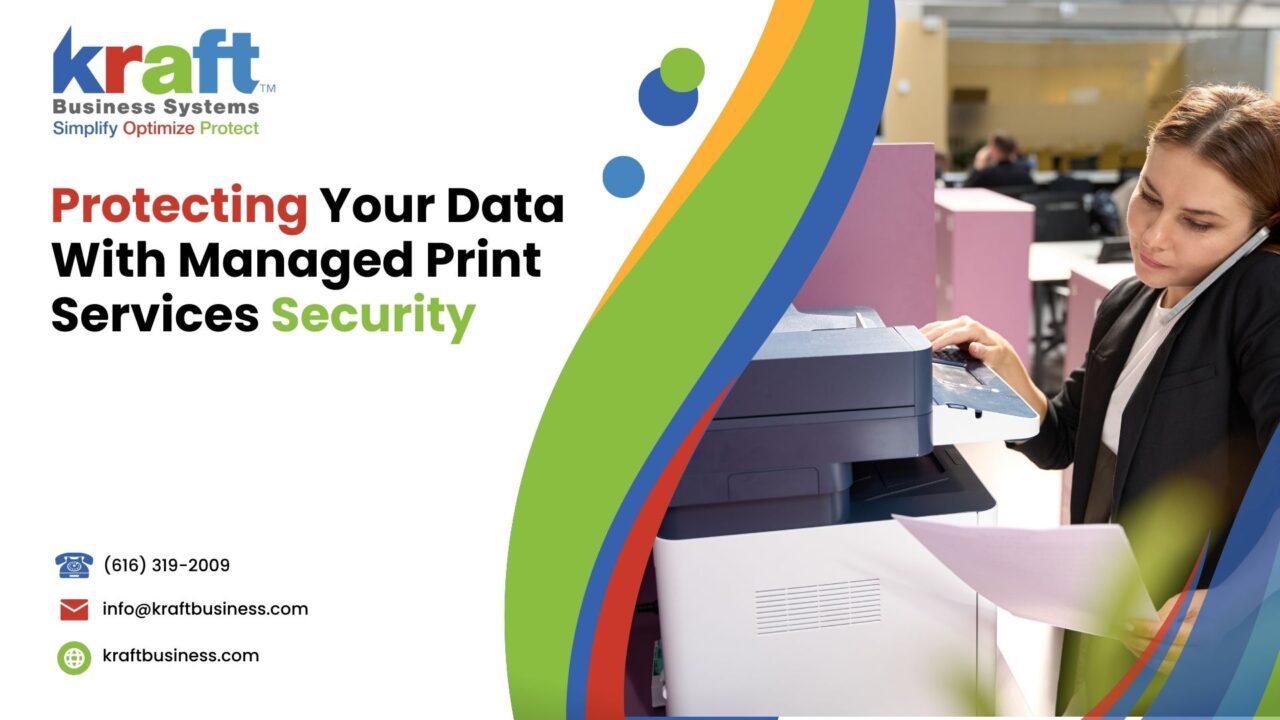Table Of Contents:
- Understand the Importance of Managed Print Services Security
- Implement Managed Print Services for Data Protection
- Protect Sensitive Information With Advanced Security Features
- Comply With Data Protection Regulations Through Secure Printing
- Educate Employees on Effective Secure Printing Practices
- Stay Ahead With Emerging Technologies in Print Security
- Frequently Asked Questions
- Conclusion
Are you continually challenged to safeguard sensitive documents amidst the relentless demand for greater productivity? A neglected aspect of data security is often the everyday use of printers and copiers within a business. This article will reveal how managed print services can strengthen your security posture, ensure efficiency in handling documents, and contribute to the sustainability of digital transformation efforts. Readers will learn to leverage advanced security features to protect against data breaches and comply with stringent regulations, without compromising on productivity or overextending on toner expenses. Engaging with this piece will arm business owners with the knowledge to transform their printers from potential liabilities into assets fortified for the digital age.
Understand the Importance of Managed Print Services Security

Within the fabric of modern workflow, the security of print environments often remains overlooked, making them vulnerable to data breaches that can have profound effects on any organization. By identifying the risks associated with unsecured printers and understanding the impact of data breaches, businesses can more effectively integrate managed print services with cloud computing and sustainability efforts. This section elucidates how managed services fortify your organizational defenses against such overlooked vulnerabilities.
Identify Risks Associated With Unsecured Printers
The risk to information security within a company’s document management system escalates when printers and multifunction devices are left unsecured. These endpoints of the corporate network can become gateways for unauthorized access if lacking proper authentication protocols. This oversight may lead to sensitive data being intercepted or compromised, calling for robust infrastructure and automation of security measures within managed print services.
Without stringent authentication measures, the printers scattered throughout an office can expose an organization to both internal and external threats. Every document passing through an unsecured device risks being an open book to prying eyes, emphasizing the importance of incorporating managed print services equipped with rigorous security features. Companies that leverage these services can significantly mitigate risk and enhance the protection of their network infrastructure.
Learn How Data Breaches Impact Your Organization
Data breaches can severely impact an organization by causing financial losses and eroding customer trust. With managed print services, companies can safeguard their print environments by implementing fleet management and mobile device management protocols. These strategies prevent unauthorized access to firmware and data, align with regulatory compliance requirements, and through scalability, accommodate the evolving needs of the business.
Moreover, the repercussions of a data breach extend to reputational damage that can compromise an organization’s market position. Managed print services provide a structured approach to securing print devices and networks, ensuring that vulnerabilities are promptly addressed and that the print infrastructure aligns with the company’s overarching cybersecurity framework. Firms with a strong security posture can avert such crises and maintain their competitive edge.
Implement Managed Print Services for Data Protection

To establish a stronghold against the increasing threat of data breaches, firms should take a close look at their current print infrastructure security. With the right Managed Print Services (MPS) provider offering advanced encryption and vulnerability management, businesses can tighten the reins on information security. This approach includes deploying innovative access control measures and integrating security-focused devices from reputable manufacturers like Lexmark. The following sections detail the steps for assessing existing infrastructure weaknesses and selecting an MPS provider that prioritizes data protection.
Assess Your Existing Print Infrastructure Security
Conducting a thorough assessment of a company’s existing print infrastructure is a vital first step in mitigating the risk of a data breach, especially in a business landscape where remote work is prevalent. This evaluation should scrutinize all facets of the print infrastructure, including hardware, firmware, and software, to identify any vulnerabilities that may exist. The help desk and IT team play pivotal roles in this evaluative process, ensuring not only the security of the company’s data but also the safety of the customer information that passes through these systems.
When assessing the print infrastructure, one must consider the demands of a modern workforce which often requires secure and agile solutions to support productivity. Managed Print Services deliver such solutions, incorporating data protection strategies effectively to shield against unauthorized access, a crucial component in the era of remote work. Companies must work closely with their Managed Print Services provider to establish robust protocols that are resilient against the increasingly sophisticated methods used in data breaches.
Choose a Secure Managed Print Services Provider
Selecting a managed print provider is an integral step in protecting a business’s data ecosystem. Firms should prioritize providers that demonstrate proficiencies in navigating the complexities of the internet of things and possess advanced analytics capabilities to monitor and manage print systems. A secure managed print provider will use analytics to anticipate potential threats and offer digitization solutions that align with the business’s unique security requirements, thereby strengthening the data ecosystem against cyber threats.
The right managed print services provider is one that aligns with a business’s drive towards enhanced data security through digitization. This provider should not only understand the intricacies of the organization’s specific needs but also possess the expertise to integrate managed print solutions into the existing network infrastructure seamlessly. By doing so, they can create an interconnected and securely monitored environment that supports both present and future operational demands.
Protect Sensitive Information With Advanced Security Features

In this era of digital information flows, safeguarding sensitive data through Managed Print Services (MPS) has become a paramount strategy for businesses. This segment discusses how enterprises can utilize user authentication and access controls, as well as implement encryption and secure print release options to fortify their information security. These resources are integral to a comprehensive IT infrastructure that includes not only the human element at the desk but also robust contractual agreements to ensure data integrity. Advanced security features offered by MPS become indispensable tools for any organization seeking to safeguard their information assets effectively.
Utilize User Authentication and Access Controls
Implementing user authentication and access controls becomes a foundational element in network security, curbing unnecessary expense and energy devoted to rectifying breaches. By deploying managed print services that require user credentials for print job releases, firms ensure that only authorized personnel access sensitive documents from any mobile device, reinforcing an environmentally friendly and secure document management system.
Adept managed print services integrate seamlessly into a business’s network, providing a shield from unauthorized access with minimal disruption to workflow. The adoption of such protocols underscores a commitment to safeguard not only the organization’s network security but also the confidential data that traverses it, affirming the foresight of enterprises in protecting their assets efficiently.
Implement Encryption and Secure Print Release Options
Integrating encryption into managed print services profoundly enhances the security of digital printing processes. It ensures that data in transit across networks remain inaccessible to unauthorized users, preserving the user experience without compromising on confidentiality. Furthermore, secure print release options demand that individuals authenticate their identities before physical ink touches paper, restricting color printing to authorized users and effectively curtailing inadvertent consumption of sensitive information.
These advanced security features not only protect the integrity of the information but also refine the overall user experience by streamlining workflows. Users gain confidence in the managed print solution knowing that their documents, whether related to color printing or confidential contracts, are safeguarded by robust encryption protocols. This conscionable approach to data handling via digital printing services supports sustainability by reducing unnecessary prints and maintaining vigilance over consumable resources.
Comply With Data Protection Regulations Through Secure Printing

In the current regulatory landscape, businesses must prioritize compliance to safeguard client data within their print environments. Compliance starts with aligning print policies and practices with stringent standards, extending itself to each print job facilitated by devices such as those offered by Ricoh. Regular security audits and assessments serve as critical tools, not merely as a policy measure, but as an asset in the continual protection of sensitive information. These components enable organizations to navigate the complexities of data protection regulations with confidence.
Align Your Print Environment With Compliance Standards
Ensuring compliance with data protection regulations requires businesses to align their print environments with current standards, a task that encompasses more than simple adherence to guidelines. It calls for an integrated approach where corporate social responsibility converges with technological efficiency to minimize the environmental footprint. An effectively managed print service accounts for these aspects by providing full visibility over an organization’s inventory of printers and multifunction devices, enabling responsible oversight right down to the end user level.
It’s not just about regulatory adherence; it’s about instilling confidence in clients and stakeholders that sensitive data is handled with the utmost care and security. A managed print services provider that excels ensures that all deployed printing solutions meet the rigid demands of information security guidelines and consistently monitors the integrity of the print environment. This commitment to maintaining a secure document flow serves to strengthen the trust that clients place in the organization’s capability to protect valuable data while managing its resources responsibly.
Conduct Regular Security Audits and Assessments
Regular security audits and assessments are imperative for businesses to ascertain the efficacy of their managed print services program. Such evaluations facilitate the detection of vulnerabilities within machines and systems early, thereby reinforcing an organization’s data security framework. For the customer, the commitment to constant vigilance translates into an improved customer experience, knowing their sensitive information is proactively protected.
Managed print services providers typically offer these security audits as part of their comprehensive suite of services, enabling businesses to regularly review and optimize their print infrastructure. Through this steady program of assessments, companies remain aligned with evolving compliance standards and technological advancements, a crucial aspect in the unending pursuit of safeguarding data and enhancing overall operational integrity.
Educate Employees on Effective Secure Printing Practices

Securing confidential documents begins with educating staff on stringent print protocols, an essential element in the broader framework of print management services. Companies committed to reinforcing printer security recognize the importance of cultivating company-wide awareness, particularly in the age of cloud printing. Managed print services provide a robust defense against potential breaches, but their efficacy is contingent on an informed and vigilant workforce. The subsequent sections delve into empowering staff with the knowledge to manage print services securely, ensuring every employee is a gatekeeper of the data they handle.
Teach Staff to Handle Confidential Documents Securely
Integral to maintaining a secure print environment is the training of staff on proper procedures for handling confidential documents. Employees should be well-versed in the latest print management strategies, including the operation of advanced printing devices from manufacturers such as Sharp, and understand how to utilize cloud print services securely. By providing this education, businesses empower their workforce to consciously guard digital print jobs and reduce the risk of sensitive information falling into the wrong hands.
A thorough understanding of print security protocols by staff ensures vigilant management of print tasks within the networked environment. Staff should be proficient in authenticating and authorizing print jobs, particularly when dealing with digital documents containing trade secrets or personal data. Through continuous training and reinforcement of data protection best practices, employees can significantly fortify the company’s defense against inadvertent breaches and cyber threats.
Promote Company-Wide Awareness of Print Security Protocols
Promoting an enterprise-wide understanding of print security protocols is fundamental for safeguarding against data breaches and malware intrusions. An effective managed print service provider equips businesses with the tools and processes necessary to ensure their fleet of printing equipment remains secure. When organizations partner with a trusted entity like Kraft Business Systems, they can rest assured that their staff will receive comprehensive training on the latest security measures, thus contributing to a robust defense against cyber threats.
It is crucial that every member of an organization understands their role in maintaining the security of the print environment. A managed print service integrates protective measures across devices, but the efficacy of such systems is dependent on an informed staff capable of recognizing and preventing security lapses. To foster this awareness, business owners are encouraged to Contact Kraft Business Systems for expert guidance on establishing secure printing practices that permeate company culture and fortify their data against unauthorized access.
Stay Ahead With Emerging Technologies in Print Security

With the rise of complex cyber threats, Kraft Business Systems emphasizes the significance of implementing cutting-edge security technologies within printing infrastructures. Managed Cybersecurity Services now encompass Office Technology Products, preparing organizations for future security challenges. The upcoming sections dissect how to integrate these advanced solutions effectively and the steps necessary to anticipate and counteract potential threats to data integrity.
Implement Cutting-Edge Security Technologies in Printing
In today’s landscape of heightened cyber risks, businesses must recognize the value of incorporating the latest security technologies within their print management strategies. Managed Print Services (MPS) providers like Kraft Business Systems are integrating biometric authentication and real-time intrusion detection systems to offer unparalleled protection. These advancements ensure that sensitive documents are printed securely, safeguarding against data breaches and reinforcing the client’s confidence in the company’s commitment to data integrity.
The integration of blockchain technology in printing processes exemplifies the innovative measures companies are adopting to elevate data protection. By logging each transaction within a tamper-evident ledger, organizations facilitate a trail of verifiable actions, rendering the manipulation of printed content far more challenging for malicious entities. This strategic approach by managed print services providers ensures businesses stay ahead of emerging threats, securing their print environments against even the most sophisticated of attacks.
Prepare Your Organization for Future Security Challenges
Preparing for future security challenges entails equipping an organization’s managed print environment with the agility to adapt to evolving threats. This can be achieved through consistent technology updates, regular training on advanced security practices, and investing in adaptive managed print services. By staying ahead of technological shifts, businesses bolster their defense mechanisms, ensuring long-term data protection within their printing infrastructure.
One practical approach to future-proofing an organization’s data security is to foster partnerships with managed print services providers that prioritize innovation in their security offerings. These providers conduct ongoing research and implement state-of-the-art security features like advanced user authentication and end-to-end encryption. By doing so, they assure that an organization’s print infrastructure is not only secure today but is also prepared to counteract future cyber threats effectively.
Frequently Asked Questions
What is managed print security and why is it critical?
Managed print security refers to protecting an organization's documents and network access involving printers and copiers. It's critical due to the sensitive data processed by these devices, ensuring confidentiality, integrity, and availability.
With the rise of cyber threats, a robust managed print security strategy prevents unauthorized access, data breaches, and compliance violations. It forms a vital part of a business's overall cybersecurity posture, safeguarding its operational continuity.
How does managed print services bolster data protection?
Managed print services implement strict user authentication and access controls, ensuring only authorized personnel can retrieve printed materials. This reduces the risk of sensitive data exposure, complying with data protection regulations.
In addition to secure release functions, these services provide encryption for documents awaiting output. Regular monitoring and reporting also identify potential security breaches, enhancing overall data protection within the organization.
What security features are vital for sensitive document handling?
When handling sensitive documents, it is essential to prioritize robust encryption protocols. These safeguard data during transit and at rest, ensuring that only authorized personnel can access the information. Additionally, secure authentication measures, like multifactor authentication (MFA), add an extra security layer.
Another critical feature is access control policies that define user permissions and track document handling. Document management systems should include audit trails, offering detailed records of who accessed each document and when, to prevent unauthorized data breaches and leaks.
Will secure printing help with data protection compliance?
Secure printing plays a critical role in upholding data protection compliance by ensuring confidential documents are only accessible to authorized personnel. By implementing advanced authentication methods, businesses can prevent unauthorized access and data breaches, aligning with compliance mandates.
Incorporating secure printing solutions creates an audit trail for printed materials, which can prove essential for compliance reviews and investigations. This practice supports adherence to regulations like GDPR, helping businesses maintain credibility and avoid potential legal penalties for non-compliance.
How can we train employees in secure printing best practices?
To instill secure printing practices in employees, it's essential to conduct regular training sessions. These should address confidentiality protocols, correct use of security features on printers, and methods for handling sensitive documents. A focus on prevention of data breaches through printed material is paramount.
Additionally, leveraging hands-on workshops where employees can experience using secure print release functions reinforces learning. It's beneficial to provide reference materials like guides and checklists for secure printing processes, ensuring continuous adherence to best practices within the workplace.
Conclusion
In today’s digitally connected business landscape, securing print environments through Managed Print Services (MPS) is crucial to protect sensitive data and maintain compliance with stringent security standards. MPS not only mitigates the risks of data breaches with advanced encryption, access controls, and user authentication but also equips organizations to adapt and respond to emerging cyber threats proactively. Regular security audits, employee education, and the implementation of cutting-edge technologies ensure that printing infrastructures are resilient against unauthorized access. By prioritizing print security, businesses can fortify their defense systems, preserve their reputation, and uphold the trust of their clients and stakeholders.






